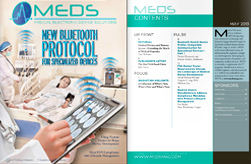AAMI, the Association for the Advancement of Medical Instrumentation, is a nonprofit organization founded in 1967. It recently held a conference in Long Beach, CA. It brought together healthcare professionals and engineers from around the world to learn, share and network under one roof. I had a chance to attend the conference and I spoke to some of the exhibitors about their new equipment and solutions. The one area that caught my attention was patient monitoring. Compared to the early stages of patient monitoring in which only temperature and blood pressure were measured, the healthcare technologies have come a long way. Several vendors exhibited devices to measure many of the patient’s vital signs.
The advancement of imaging, wireless and modular design has propelled the industry to create impressive devices such as advanced Anesthesia Monitoring Systems with large HD displays. For example, Nihon Kohden America, with its headquarters in Japan, has introduced the GF-210RA general purpose anesthesia monitoring system that provides measurement of anesthesia gases including CO 2, N2O, O2 and two anesthetic agents (automatically selected from Halothane, Isoflurance, Enflurance, Sevoflurane, Desflurance) and respiration rate. The monitor window displays five waveforms in color (O2, CO 2, N2O and two agents). On the side of the unit is a modular plug in with various types of connectors. While this is convenient, most of the vendors, unfortunately, have their own unit interface and connectors/cables. The idea of having universal plug-and-play interoperability is many years away. In addition to the wall-mount or desktop units, Nihon Kohden also provides portable units with less signal display for special needs.
Spacelabs Healthcare also launched a new high-performance anesthesia delivery system.The Arkon system includes not only a touchscreen display, but it also has adjustable lighting and is mounted on a wheeled cart with working space including desk drawers and movable shelves like in the office. This expandable work surface comes with multiple electrical outlets and built-in USB and Ethernet ports. This innovative system provides a combination of maximum functionality and ergonomics not previously available for this market.
Also at the conference, Masimo demonstrated a stand-alone device for patient bedside monitoring. The Radical-7 is a detachable, battery-operated wireless handheld unit that can also be worn for easy movement of the patients. This unit can also be easily plugged into a desktop station for a larger display.
Located not too far away from Masimo at the conference was Welch Allyn, which integrated Masimo’s advanced Pulse CO-Oximetry technology into its new Connex Vital Signs Monitor. The system measures blood pressure, pulse rate, temperature, pulse oximetry and hemoglobin, and has the wireless capability to send EMR to anywhere desired. The device also gives the clinician the ability to customize alarms, patient data and monitoring, and document the data right on the device.
From the various vendors at this conference, one has the sense that patient vital sign monitoring technology will keep improving to provide caregivers more convenience, control and accuracy. On the other hand, providing Electronic Medical Record (EMR) systems is still a challenge because it requires integration and having the data available in a universally acceptable format. Balancing the need for privacy and the availability of EMR in the medical industry remains a challenge.

